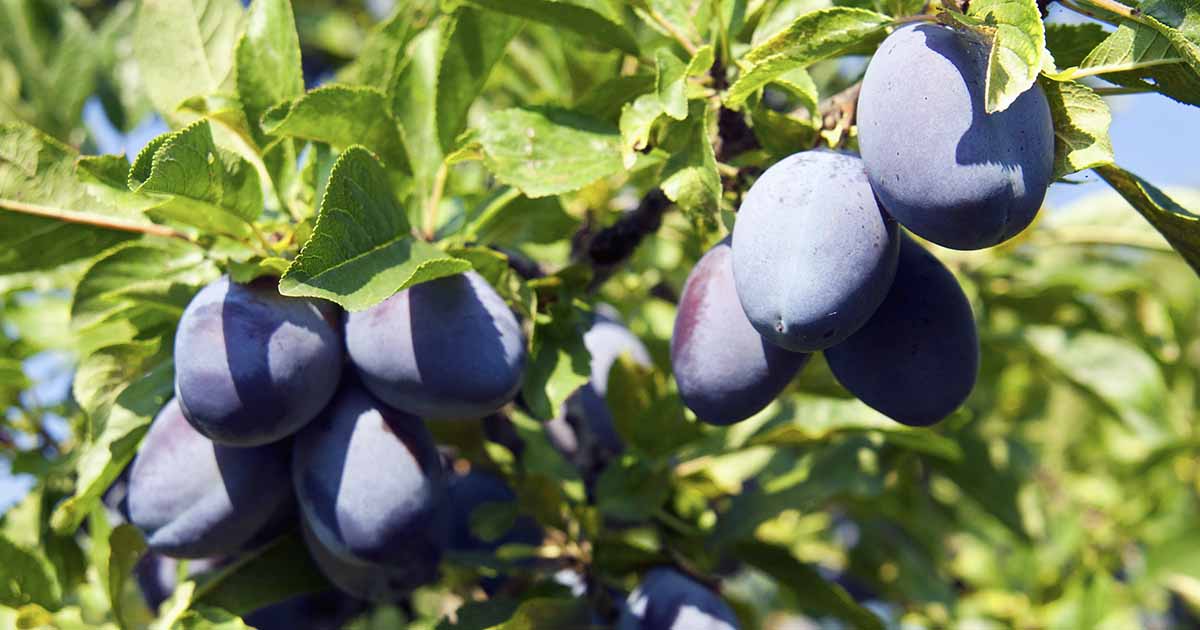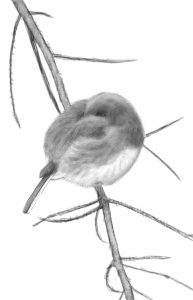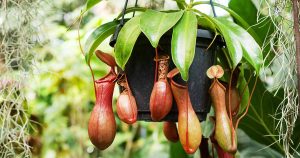
Most fruit trees are greedy, commonly known as heavy feeders, and plums (Prunus spp.) are no exception.
Horticulturalists have bred modern plum trees to bear an abundance of fruits, and that means the plants need plenty of nutrients to feed all this production.

We link to vendors to help you find relevant products. If you buy from one of our links, we may earn a commission.
In our guide to growing plums, we cover how to cultivate these fruit trees in your landscape.
And when it comes to fertilization, there’s a lot more to it than just tossing out some granules occasionally and calling it a day.
In this guide, we’re going to discuss when and how to feed your plum trees for maximum production and healthy plants.
Here’s what’s coming up:
How to Fertilize Plum Trees
Before you even think about buying a bag of fertilizer, I highly recommend that you test your soil.
Here’s why:
Test Your Soil
When I started out gardening, I was always told I should conduct a soil test every year but I skipped this step for a long time, assuming that if I simply applied fertilizer regularly my plants would have everything that they need.

Then, one year, I decided to take this excellent advice and test my soil.
And it was only when I saw the results that I realized that I had been wasting money by adding a bunch of nutrients to my soil that wasn’t needed.
Not only was I wasting money, but I was inadvertently harming the environment because a lot of that extra stuff was being washed off into local water resources.
Soil tests are cheap and easy, so there’s really no good reason to skip them. You can purchase reliable at-home test kits at your local garden center or online.
I use the MySoil test kit, available via Amazon.
I’ve used this kit for several years and I have even compared the results with a sample sent to my local extension and they both lined up.
You’ll receive the pH level of the soil as well as an in-depth analysis of all the major micro and macronutrients, along with fertilizer recommendations.
Or, send a sample of the soil to your local university’s extension office.
When you receive your results, follow the recommendations for which amendments to apply.
They’ll tell you if your soil is high in one nutrient and low in another so you can add what’s needed without adding what’s not needed.
Choosing a Fertilizer
For your plum trees you can use either organic or conventional fertilizer, and choose from slow release or instant.
Soil feeds rather than foliar sprays work best for plums, but you can use liquid or granules to fertilize the earth.

Slow release fertilizer is less likely to be leached out of the soil by rain and irrigation, and is less likely to burn the roots of your trees than fast-acting liquid fertilizer.
Organic fertilizers are made from naturally occurring plant or animal sources like blood, bone, or fish meal. Well-rotted compost or manure falls into this category, as well.
Conventional fertilizers are made by processing minerals and chemicals.
It doesn’t matter which you prefer, both will get the job done.
What you need to apply depends on what your test revealed. If you need to focus on adding nitrogen, for example, using a product like blood meal will work.
You can find bone meal available in eight-ounce, four-, 20-, and 50-pound bags at Arbico Organics.
If you didn’t do a test or the results reveal that you are growing your plums in fairly balanced soil, you’ll want two different foods to apply at different times of year.
The first should be a balanced 10-10-10 or 8–8-8 (NPK) food.
The Andersons make a good conventional option with added micronutrients like copper, sulfur, and zinc, which are often forgotten elements in other fertilizers.
The Andersons Balanced Fertilizer
Nab yourself an 18-pound bag at Amazon.
Then you’ll need to add a food that is formulated for fruit trees, like Down to Earth’s Fruit Tree fertilizer, which is natural and made from organic materials like feather, fish bone, alfalfa, and kelp meals.
It’s available at Arbico Organics in five-, 15-, and 25-pound bags.
When to Fertilize Plums
In many cases, you can skip feeding your plum trees during the first year after planting – provided you amend the soil when you put the plant into the ground.
The exception is if your test reveals specific nutrient deficiencies in the soil. If you can, amend the year before planting so it’s ready to go.

When you plant your plum, remove the soil from the hole and work in whatever nutrients your soil test indicates are needed. The exception is nitrogen – you want to top-dress the earth with nitrogen.
Work in any potassium or phosphorus you need into the soil you removed, and then use this soil when you backfill the hole at planting time.
Then, top dress with nitrogen if your soil indicates that’s what you need to add.
Don’t let any of the nitrogen fertilizer touch the trunk of the new plum. tree, as nitrogen burns plant matter, so do not put a nitrogen-containing fertilizer in the hole with the plant.
If your soil is depleted in general, then you can feed your young plum trees as you would established specimens.
It’s best to feed your established plum trees in early spring just as the leaves begin to bud out and when the soil isn’t frozen solid.
Apply a second round of fertilizer in midsummer.
For the first feed in the spring, find a 10-10-10 fertilizer, like the product recommended above, unless your soil test indicates that you should use something different.
You want to apply about a cup of fertilizer for each year of the age of the tree up to a maximum of 12 cups.
Of course, if the manufacturer of the product you have selected suggests otherwise, defer to their recommendations. Different formulations require you to apply different amounts.
Sprinkle or soak the fertilizer evenly around the plum tree, starting a few inches out from the trunk and out to the drip line of the tree.
If you picture the canopy of the tree as a big umbrella, the area where the water would run off the outer part of the umbrella is what we call the drip line.
Then, in the summer a few weeks before the fruits start to ripen, feed the plums again with a fruit-specific food following the same steps.
Well-Fed Trees Make Lots of Food
Imagine trying to run a marathon on nothing but a kernel of popcorn.
That’s what you’re asking your plums to do if you don’t provide them with the nutrients they need to produce an abundant harvest.
Thank goodness that feeding is one of the less taxing parts of fruit tree maintenance.

Now let’s talk about the most important part of growing plums: recipes! What are you going to do with your plums? Do tell! Fill me in on your big plans in the comments section below.
There’s a lot more to learn about raising plum trees and we’ve got the guides to help you grow a productive orchard. Check these out next:









